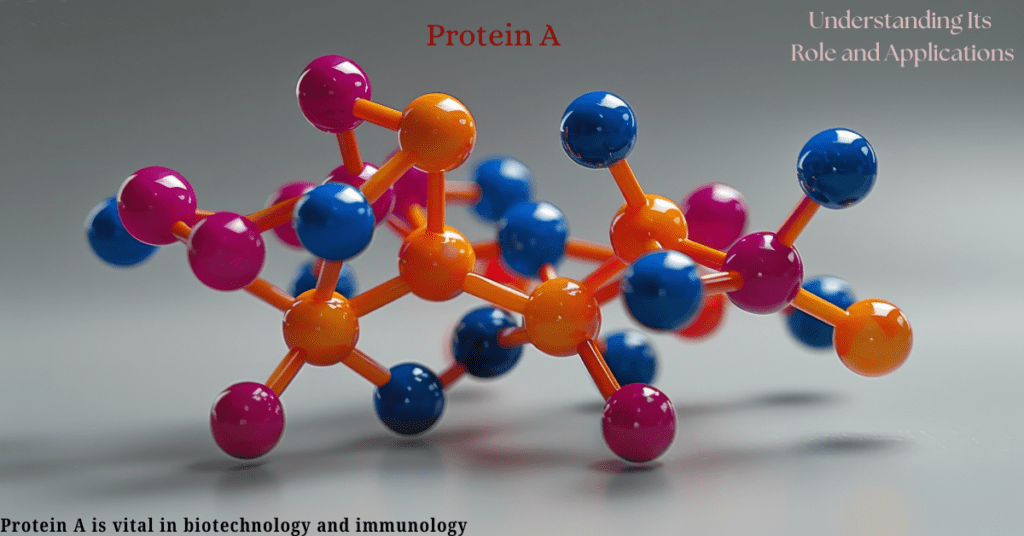Protein A is vital in biotechnology and immunology. It comes from the cell wall of a rare bacterium, Staphylococcus aureus. This protein can attach to immunoglobulin G (IgG). It is a common antibody in many mammals. It can also bind to certain types of immunoglobulin M (IgM) and immunoglobulin A (IgA). “Protein a” binds all over. It attaches well to antibodies. Thus, it is a key tool in many biochemical and clinical applications.
Structure and Binding Properties of Protein A
Protein A has several domains. They engage with the Fc domain of antibodies. This allows it to bind and isolate these molecules. This interaction is not random. It works by a precise mechanism. “Protein a” has a strong affinity for the Fc part of IgG antibodies. This makes it vital for purification. Its high affinity ensures efficient, precise extraction of target antibodies from complex mixtures. This amazing specificity leaves other molecules untouched. It revolutionizes antibody isolation in labs and industry. “Protein a”is unique properties have transformed the field. They enable more accurate and streamlined separations than ever before.

Applications of Protein A in Biotechnology
Protein A is popular in biotechnology and research. It serves the main function of purifying antibodies. It is a key component in affinity chromatography. Researchers immobilize “Protein a” on a resin or bead matrix. It makes a column. It extracts IgG antibodies from blood or cell culture fluids. This method ensures purity, making them vital for tests, treatments, and research.
Another function of “Protein a” is in immunoprecipitation. It helps isolate specific antigen-antibody complexes. “Protein a” can “pull down” the complex by binding to IgG antibodies. This lets researchers analyze its components and interactions. This technique is common in cell biology. It studies protein interactions, signaling pathways, and cellular responses.
Protein A is also used in the development of diagnostic assays. Its binding specificity makes it a good capture agent in immunoassays. It helps detect and quantify specific antibodies in a sample. These assays are key. They diagnose diseases, check immune responses, and perform serological tests.
Advantages and Limitations of Using Protein A
Protein A has many benefits, like high binding affinity and selectivity. But we must consider its limitations. For example, it does not bind well to antibodies from all species or subclasses. The interaction with certain IgG subclasses may vary by antibody source. This could affect the efficiency of purification or analysis in some cases. Also, “Protein a” can be costly for large-scale use. This may limit its use in some research or industrial settings.

IgA and IgM
IgA and IgM are vital antibodies that fight infections in different ways.
IgA (Immunoglobulin A)
From lungs to breast milk, IgA stands guard. This vital defender blocks invaders, preventing bacteria and viruses from gaining a foothold. By stopping pathogens from adhering to surfaces, IgA forms a crucial barrier. It shields the bloodstream. It keeps our body is first defense in saliva and tears.
IgM (Immunoglobulin M)
IgM is the largest antibody. It is the first made during an infection. It’s in the main found in blood and lymph. IgM is key for early infection detection and response. It binds to pathogens to destroy them. Its size allows IgM to form large complexes with antigens. Antigens are foreign invaders. They trigger immune reactions. IgM is vital for early immunity. It also prompts the body to produce long-term antibodies, like IgG.
IgA and IgM are vital to the immune response. Each protects the body in specific ways and at different stages of infection.
Conclusion
Protein A, with its unique binding abilities, is vital in biotech and immunology. Its value in research and clinical settings is well recognized. It spans from antibody purification to diagnostic assays. As technology advances, research seeks to optimize its use. It aims to overcome its limits and boost its effectiveness in science and medicine.
FAQs
Why is Protein A often used in antibody purification?
“Protein a” is iron grip on IgG antibodies’ Fc region enables precise isolation. This unique binding power makes it the best tool for purifying antibodies. Scientists use it to isolate key compounds from complex mixtures. Its precision lets psychologists and researchers extract key molecules with great haste.
Can Protein A bind antibodies from all species?
No, Protein a does not bind all antibodies. It forms a strong bond with IgG from various mammals. But it may bind less to antibodies from different species or subclasses.
What are the main applications of Protein A?
“Protein a” binds tightly to IgG antibodies. Researchers use it to purify antibodies, in immunoprecipitation, and for tests.





